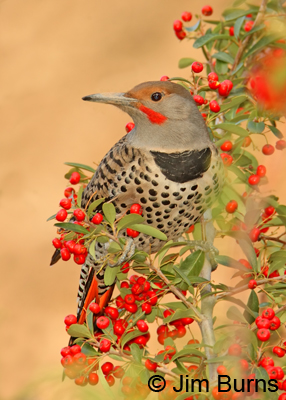
Nature lovers know BTA to be the most beautiful and serene natural area within close driving distance of the Valley. Serious birders know BTA to be the best birding site in central Arizona. If you missed the peak of fall color at the arboretum during Thanksgiving week, don’t miss the peak of winter birding there which is right now through January. Here’s a Cliff’s Notes verbal map to birding at BTA.
I’m going to take you on a clockwise loop from the Visitors’ Center so that you’ll have the sun at your back for best viewing through the best areas, and it will put you in the shadier, chillier areas after the morning sun has warmed them up. (This is, after all, the middle of winter and BTA is high desert, so you need to dress in layers). We’re walking east through the Cactus Garden (Cactus Wren and Phainopepla) and climbing the hill to Ayer Lake (Pied-billed Grebe and maybe Ring-necked Duck). Stop on the deck and listen for Marsh Wrens and Soras in the reeds at your feet.
As you continue up the hill toward Picketpost House and the high point of the park, watch for displaying Anna’s Hummingbirds and foraging Black-throated Sparrows. Before descending the switchbacks to Queen Creek scan the skies for raptors. Red-tails or the resident Cooper’s Hawks might be riding a thermal, and one year a Zone-tailed lingered all winter. The cliff faces on the descent are excellent for both Rock and Canyon Wrens, and you might tie an arboretum record by recording seven(!) wren species in one day.
As you enter the riparian area at the bottom of the switchbacks and head west along the creek watch for mixed species flocks foraging through the upper stories—woodpeckers, kinglets, Verdins, nuthatches, and if you’re lucky, perhaps a vagrant eastern warbler. Check out the Myrtle bush by the pump house for berry specialists like robins and thrushes, and don’t forget Coati’s love fruit too. Typically in all seasons the Herb Garden area is the birdiest place at BTA. Here you should at least find mixed wintering sparrow flocks and several flavors of woodpecker. This is also the surest place I know in Arizona to see Northern Cardinals.
Continue on through the Eucalyptus grove, which hosts the Cooper’s Hawks’ nests during breeding season, watch for flycatchers in the picnic area, then sit for a few minutes at the waterfall behind the entrance wall in the Demo Garden to see what comes to drink and bathe. Your final stop is the hummingbird garden where you’ll find Anna’s and Broad-billeds coming to the feeders.
BTA has become my default nature stop, and I know even if I don’t see many birds there on a given visit, I’ll be refreshed and ready for my next foray into the real world called “life.” Christmas season, busy and commercial as it has become, is still and always a season for reflection and reconnection. BTA’s beauty and solitude provide the perfect setting for this.